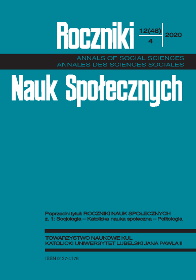Stawka i konflikt jako mechanizmy budowania suspensu w filmach o Jamesie Bondzie. Raport z badań
Abstrakt
Stawka odgrywa istotną rolę przy intensyfikowaniu konfliktu pomiędzy protagonistą a antagonistą, a co za tym idzie: emocjonalnej reakcji odbiorcy na ten konflikt. W filmach o Jamesie Bondzie stosowany jest schemat fabularny zapobiegania tragedii, gdzie główny bohater ma powstrzymywać złoczyńcę przed realizacją moralnie złego planu. Modyfikowanie stawki odbywa się przez maskowanie stawki rzeczywistej, zwiększanie negatywnych konsekwencji porażki, zwiększanie pozytywnych konsekwencji zwycięstwa oraz zmniejszanie możliwości osiągnięcia celu. Ponad to filmy te cechuje globalny charakter konfliktu, który uwydatnia się na dwóch poziomach − na poziomie skali zagrożenia, gdzie cele publiczne (konsekwencje polityczne, ekonomiczne, społeczne, humanitarne) są ważniejsze niż cele prywatne (konsekwencje emocjonalne, moralne), oraz na poziomie formy zagrożenia, gdzie stawka konfliktu jest osadzona na lęku fantastycznym. Absurdalność i karykaturalność zagrożeń jest urzeczywistniana przez przedstawianie ich w kontekście konfliktu wartości (np. dobro kontra zło).
Bibliografia
Bell J.S., Plot and structure: Techniques and exercises for crafting a plot that grips readers from start to finish, Cincinnati: Writer’s Digest Books 2004.
Black J., The world of James Bond: The lives and times of 007, Lanham: Rowman and Littlefield 2017.
Brake M., The Science of James Bond: The Super-Villains, Tech, and Spy-Craft Behind the Film and Fiction, New York: Skyhorse Publishing 2020.
Carroll N., Toward a theory of film suspense, „Persistence of vision” 1984, nr 1, s. 65-89.
Comisky P., Bryant J., Factors involved in generating suspense, „Human Communication Research” 1982, nr 1, s. 49-58.
Dodds K., Screening Geopolitics: James Bond and the Early Cold War films (1962-1967), „Geopolitics” 2005, nr 2, s. 266-289.
Funnell L., Dobbs K., Geographies, Genders and Geopolitics of James Bond, London: Palgrave Macmillan 2016.
Gerrig R., The Resiliency of Suspense, w: Suspense: Conceptualizations, Theoretical Analyses, and Empirical Explorations, red. P. Vorderer, H. Wulff, M. Friedrichsen, London: Routledge 1996, s. 93-105.
Hardy J., Understanding conflict, United States: Fiction University Press 2017.
Hendrykowski M., Słownik terminów filmowych, Poznań: Ars Nova 1994.
Jose P., Brewer W., Development of Story Liking: Character Identification, Suspense, and Outcome Resolution, „Developmental Psychology” 1984, nr 5, s. 911-924.
Madrigal R., Bee C., Chen J., LaBarge M., The Effect of Suspense on Enjoyment Following a Desirable Outcome: The Mediating Role of Relief, „Media Psychology” 2011, nr 3, s. 259-288.
Morrell J., Between the lines: master the subtle elements of fiction writing, Cincinnati: Writer’s Digest Books 2006.
Newton M., Writing Thrillers: The Writerʼs Guide to Crafting Tales of Suspense, Cincinnati: Writer’s Digest Books 2013.
Obstfeld R., Fiction First Aid, Cincinnati: Writer’s Digest Books 2001.
Ortony A., Clore G., Collins A., The Cognitive Structure of Emotions, Cambridge: Cambridge University Press 1990.
Smith J., „How Safe Do You Feel?”: James Bond, Skyfall, and the Politics of the Secret Agent in an Age of Ubiquitous Threat, „College Literature” 2016, nr 1, s. 145-172.
Smuts A., The Desire-Frustration Theory of Suspense, „The Journal of Aesthetics and Art Criticism” 2008, nr 3, s. 281-290.
Truffaut F., Hitchcock/Truffaut, tłum. T. Lubelski, Izabelin: Świat Literacki 2005.
Wied de M., The role of temporal expectancies in the production of film suspense, „Poetics” 1995, nr 1, s. 107-123.
Zillmann D., Mechanisms of emotional involvement with drama, „Poetics” 1994, nr 23, s. 33-51.
Zillmann D., Hay T.A., Bryant J., The effect on suspense and its resolution on the appreciation of dramatic presentations, „Journal of Research Personality” 1975, nr 9, s. 307-323.
Zillmann D., The psychology of suspense in dramatic exposition, w: Suspense: Conceptualizations, Theoretical Analyses, and Empirical Explorations, red. P. Vorderer, H. Wulff, M. Friedrichsen, London: Routledge 1996, s. 199-232.
Copyright (c) 2020 Roczniki Nauk Społecznych

Utwór dostępny jest na licencji Creative Commons Uznanie autorstwa – Użycie niekomercyjne – Bez utworów zależnych 4.0 Międzynarodowe.


